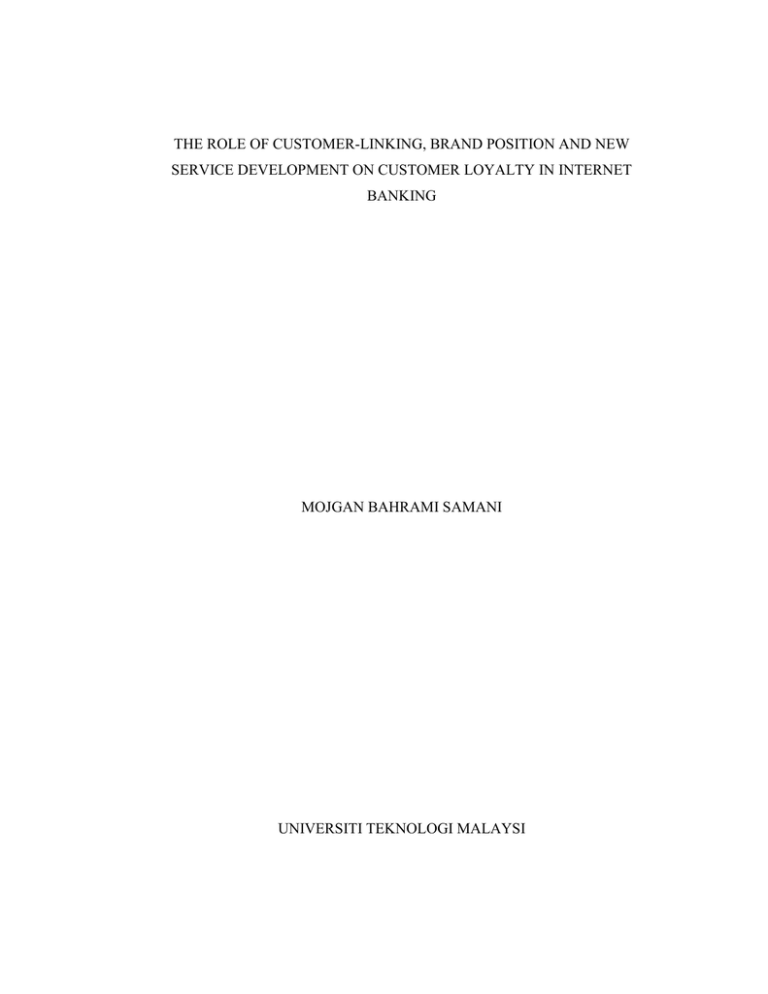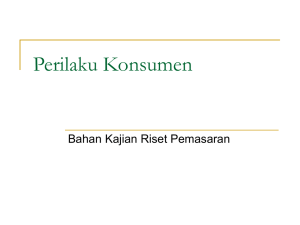i THE ROLE OF CUSTOMER-LINKING, BRAND POSITION AND NEW
advertisement

i THE ROLE OF CUSTOMER-LINKING, BRAND POSITION AND NEW SERVICE DEVELOPMENT ON CUSTOMER LOYALTY IN INTERNET BANKING MOJGAN BAHRAMI SAMANI UNIVERSITI TEKNOLOGI MALAYSI v THE ROLE OF CUSTOMER-LINKING, BRAND POSITION AND NEW SERVICE DEVELOPMENT ON CUSTOMER LOYALTY IN INTERNET BANKING MOJGAN BAHRAMI SAMANI A thesis submitted in fulfilment of the requirements for the award of the degree of Doctor of Philosophy (Management) Faculty of Management Universiti Teknologi Malaysia AUGUST 2013 vii To my lovely father, mother and husband. Their support, encouragement, and constant love have sustained me throughout my life viii ACKNOWLEDGEMENT I take this opportunity to express my profound gratitude and deep regards to my guide, Dr. Noor Hazarina Binti Hashim, for her exemplary guidance, monitoring and constant encouragement throughout the course of this thesis. The blessing, help and guidance given by her time to time shall carry me a long way in the journey of life on which I am about to embark. I also take this opportunity to express a deep sense of gratitude to my cosupervisor, Dr Md. Razib bin Arshad, for his cordial support, valuable information and guidance, which helped me in completing this task through various stages. My special thanks are due to my beloved husband, Dr Naser Khani, the most faithful and helpful friends that I have ever had. His sincere, endless assistance and friendship have helped me tremendously throughout the course of my studies. To my joyful son, Mehrbod, has made my study more enjoyable. I express my warmest affection. To my family, my deepest gratitude and thankfulness are especially conveyed to my dearest mother ‘Farangis’ and father ‘Hossein’ for their ceaseless prayer for my success, their love and confidence , I am what I am today mainly because of the two of you. Also, thank you to my sister ‘Mahsa’ and brother ‘Masoud’ for their kindness. ix ABSTRACT There is a consensus among researcher that businesses should not only consider gaining new customers, but to include building long-term relationships with existing customers. Literature posits that building and sustaining loyal customers create positive returns for a firm and this is important in service industries. However, despite the growing interest among researchers to measure customer loyalty, there are inconclusive theoretical studies measuring customer loyalty. Previous studies investigated how customers’ emotions, senses, perceptions, reputations and personal values affect their loyalty towards a firm. The main weakness of previous studies is that they neglected the organizational aspects of firm that influenced customers’ satisfaction and loyalty as a non-financial performance. In this regard, an organization capability and ability plays a vital role in producing satisfied and loyal customers particularly in service sector. Using Resource-Based View theory, this study attempted to fill the gap in existing literature by investigating the relationship between the outcomes of marketing capabilities of an organization and customer’s satisfaction and loyalty. Marketing capabilities in this study includes customer-linking, brand and innovation. In addition, this study investigated the moderating effects of Internet perceived risk and website knowledge towards satisfaction and loyalty in electronic banking. These variables were empirically tested on customers of Iranian banking industry who have experienced Internet-banking services. Using a survey questionnaire, data were collected and analyzed by Partial Least Square software. The result showed that there are significant relationship between customer-linking, brand position and new service development with customer loyalty. In addition, the findings supported moderating role of Internet perceived risk and website knowledge on the relationship between brand position and customer loyalty. Nonetheless, contrary to previous studies, this study found Internet perceived risk and website knowledge of customers has no significant effect on customer loyalty. In addition, the result shows that government banks performed better than private banks. In summary, the result indicated that the variance of customer loyalty could be explained according to the outcomes of organizational capabilities. x ABSTRAK Penyelidik umum bersetuju bahawa perniagaan tidak seharusnya memfokus kepada pencarian pelanggan baru, tanpa usaha untuk membina hubungan jangka panjang yang baik dengan pelanggan yang sedia ada. Kajian mencadangkan bahawa dengan membina dan mengekalkan kepuasan pelanggan setia dapat mencipta pulangan yang positif untuk firma terutama dalam industri perkhidmatan. Walaupun terdapat minat yang semakin meningkat di kalangan penyelidik untuk mengukur kesetiaan pelanggan, namun belum ada lagi kata sepakat mengenai kaedah terbaik untuk mengukur kesetiaan pelanggan. Kajian lepas telah menyelidik bagaimana emosi, deria, persepsi, reputasi dan nilai diri pelanggan memberi kesan kepada kesetiaan mereka. Walaubagaimanapun, antara kelemahan utama dalam kajian lepas adalah kurang penekanan tentang peranan keupayaan organisasi dalam pembentukan kepuasan dan kesetiaan pelanggan. Dengan menggunakan teori Berasaskan-Sumber, kajian ini bertujuan untuk memperbaiki penyelidikan yang sedia ada dengan mengkaji hubungan antara hasil daripada keupayaan pemasaran organisasi dengan kepuasan dan kesetiaan pelanggan. Keupayaan pemasaran dalam kajian ini termasuklah keupayaan menghubungkan pelanggan, keupayaan jenama dan keupayaan inovasi. Selain itu, kajian ini menyelidik kaitan antara persepsi risiko Internet dan pengetahuan laman web terhadap kepuasan dan kesetiaan dalam perbankan elektronik. Pembolehubah ini diuji pada pelanggan yang mempunyai pengalaman menggunakan perkhidmatan perbankan Internet di Iran. Dengan menggunakan soal-selidik, data telah dikumpul dan dianalisa oleh perisian Partial Least Square. Keputusannya menunjukkan hubungan yang signifikan antara keupayaan menghubungkan pelanggan, kedudukan jenama dan pembangunan perkhidmatan baru dengan prestasi bukan kewangan (sebagai contoh, kepuasan dan kesetiaan). Walau bagaimanapun, kajian ini tidak menemui hubungan signifikan antara persepsi risiko Internet dan pengetahuan laman web dan kedudukan jenama dengan prestasi bukan kewangan. Dapatan kajian juga menunjukkan bank kerajaan mempunyai prestasi yang lebih baik berbanding bank swasta. Kesimpulannya, kajian ini menunjukkan bahawa prestasi bukan kewangan dapat dijelaskan berdasarkan hasil keupayaan berorganisasi.
